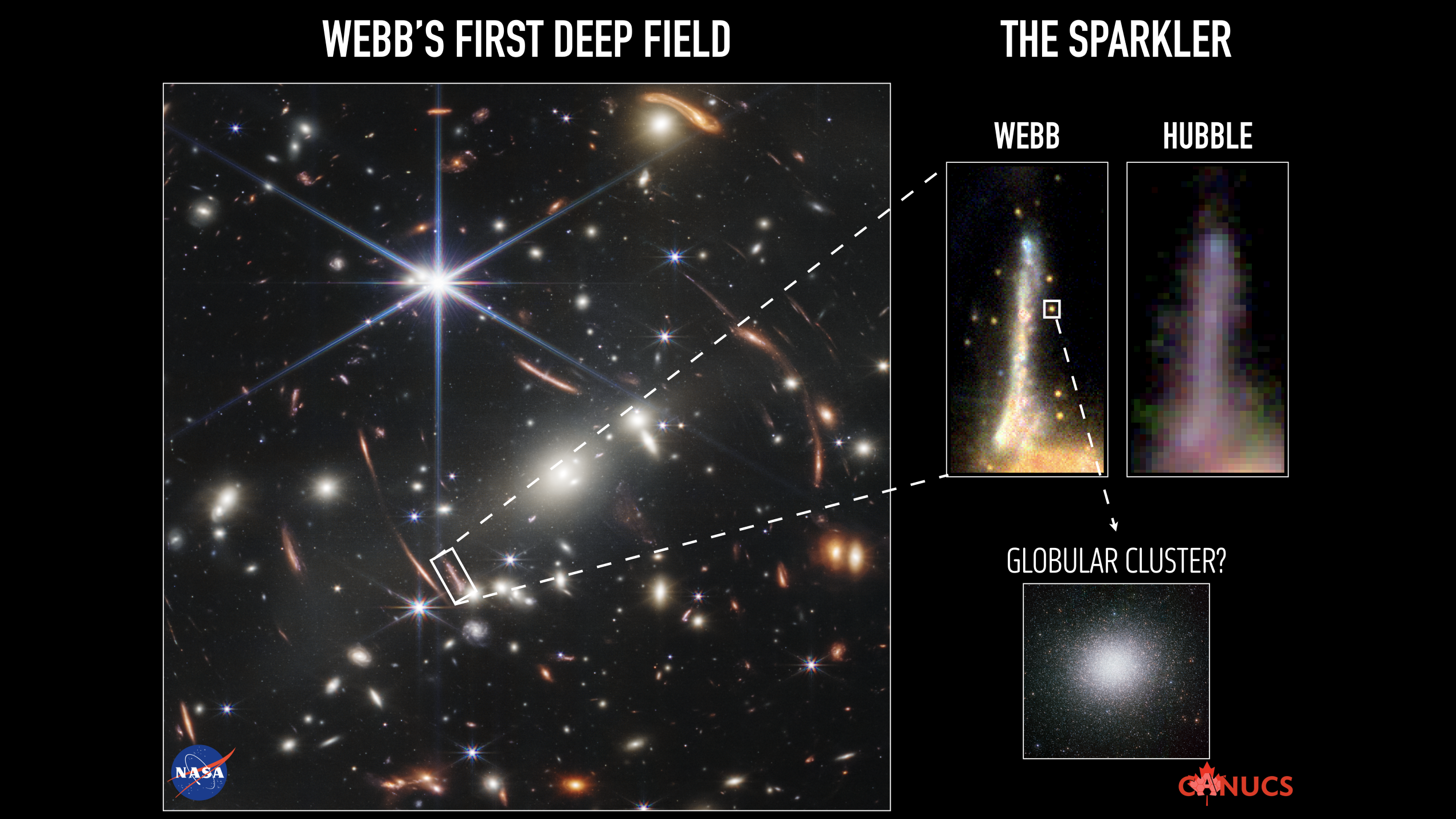James Webb Space Telescope spots 'Sparkler Galaxy' that could host universe's 1st stars

The first science-quality image revealed from NASA's newest space telescope contained a hidden treasure in the form of a sparking distant galaxy surrounded by dense clusters that could contain some of the universe's first stars.
That image, the first deep-field image from the James Webb Space Telescope (JWST), offered a stunning array of galaxies. And a team of Canadian astronomers have zoomed in on a galaxy located 9 billion light-years away from Earth, dubbed the "Sparkler Galaxy" because the compact objects surrounding it appear as small sparkling yellow-red dots. The galaxy is remarkable in itself for its weird stretched appearance, but the surrounding objects that inspired the nickname are of particular scientific interest, since they could be the most distant globular clusters of stars ever found by astronomers.
Globular clusters are collections of ancient stars that date back to a galaxy's infancy, so they can contain clues about the early stages of galactic formation, growth and evolution. Looking at the 12 compact objects surrounding the Sparkler Galaxy, the Canadian NIRISS Unbiased Cluster Survey (CANUCS) team that found five of them are indeed globular clusters. Moreover, these could be some of the oldest globular clusters ever seen, perhaps dating back to the time when the universe first began to birth stars.
"It was really surprising to us that that we were able to find such a unique object so early on in the JWST data," Kartheik G. Iyer, an astronomer at the University of Toronto in Canada and co-lead author of the study, told Space.com. "According to our analysis, we found that most of these sparkles around the main body of the galaxy are really massive and really old, stellar systems."
Related: James Webb Space Telescope's 'jewel-filled' photo is stunning. But what are we even looking at here?
The JWST image allowed the team to observe the 'sparkles' across a range of wavelengths, Iyer noted, meaning the scientists could model the clusters precisely to better understand their physical properties, including their age and the number of stars they contain. Using such distant globular clusters to date the first stars in faraway early galaxies wasn't possible before JWST.
"What we're trying to do is we're trying to age-date all the objects in the universe — the stars, the galaxies and the globular clusters — because we want to know, when is it that stars started to be born?" Lamiya Mowla, the study's co-author and also an astronomer at the University of Toronto, told Space.com.
Get the Space.com Newsletter
Breaking space news, the latest updates on rocket launches, skywatching events and more!
The Milky Way contains an estimated 150 globular clusters, but scientists have struggled to determine their ages. Mowla explained that while it is relatively easy to age-date most things in our galaxy, this isn't the case with particularly ancient objects, which already appear old when viewed up-close and thus more recently in time. It's much easier to date more distant clusters like the Sparkler Galaxy, which astronomers see as they were 9 billion years ago, when the cluster was much younger and the universe itself just 4.5 billion years old.
Think of globular clusters aging like humans do, Mowla said. "Aging globular clusters in the Milky Way is like looking at a picture trying to say if a person is 50 years old or if this person is a 55-year-old," she said. "It's easier to tell if somebody is 5 years old or if they're 10 years old. It's even easier to tell if they are a 1-year-old or if they're a 6-year-old."
And because astronomers are seeing the globular clusters surrounding the Sparkler Galaxy as they were 9 billion years ago, they look very young, making determining their age like looking at the image of the infant rather than the middle-aged person.

The astronomers further confirmed the age of the clusters using data from the Canadian-made Near-Infrared Imager and Slitless Spectrograph (NIRISS) instrument on the JWST. NIRISS observations revealed no sign of oxygen, which is usually associated with young clusters that are actively forming stars.
The JWST got an assist in the observation of the Sparkler Galaxy from both the Hubble Space Telescope, which has observed the galaxy before but was unable to resolve the globular clusters surrounding it, and from a natural phenomenon called gravitational lensing.
A helping hand from general relativity
Gravitational lensing was first predicted in 1915 by Einstein's theory of general relativity and has since become a powerful tool for astronomers.
General relativity says that objects of great mass curve the fabric of spacetime. Think of this as akin to placing balls of increasing mass on a stretched rubber sheet: the larger the mass, the greater the "dent," or curvature, it causes. In space, this curvature bends the path of light. When the mass of a foreground lensing object is extreme, this can make a background object — the source of this light — appear much larger or in multiple places in an image.
Gravitational lensing is what gives the Sparkler Galaxy its weird, stretched shape and magnifies it enough for JWST to spot it. The phenomenon also makes several of the surrounding clusters appear at multiple points in the JWST deep-field image.
Together, the magnification and the multiple images created by gravitational lensing both helped with the study of these objects but also helped confirm that these clusters do indeed orbit the Sparkler Galaxy and aren't just "overlaid" on top of it in JWST's line of view.
One of the remaining questions surrounding the Sparkler Galaxy is just how much the foreground lensing object, the SMACS 0723 galaxy cluster, is magnifying it.
"The magnification of the Sparkler Galaxy and its surroundings is not as well constrained as we'd like," Iyer said. "So one of the things we want to do is build a better magnification model so that we can figure out whether it's enlarged by a factor of 10 or by a factor of 100."
Figuring out by how much the Sparkler Galaxy and its clusters are magnified could help determine properties such as their age and their distance from Earth more precisely.
The CANUCS team will also be using JWST telescope in October to study five massive clusters of galaxies, around which they expect to find more systems like those around the Sparkler Galaxy.
"We hope the knowledge that globular clusters can be observed at from such great distances with the JWST will spur further science and searches for similar objects," Iyer said.
The James Webb Space Telescope's impact on astronomy
Astronomers and space fans alike had eagerly awaited the release of JWST's first images. Iyer said that some of his CANUCS colleagues didn't sleep on the night that the deep-field image was revealed, and Mowla looked back on the excitement of the night and how quickly the search for important cosmic objects began.
"The big reveal came from NASA in the evening and the next day the whole CANUCS collaboration were together looking at this image together," Mowla said.
"Then we saw this weirdly shaped highly lensed system," she added. "Even in the color image this thing pops out and there are these star clusters, like these little dots, that you don't see in other galaxies."
The discovery of such distant globular clusters in the first deep-field image from JWST is an example of how the telescope is continuing to deliver impressive findings and, in the process, shaping astronomy's future, they said. The duo are referring to the fact that while the Sparkler Galaxy and its globular companions are distant enough to be seen when the universe was only about 4 billion years old, this is still comparatively close considering that the JWST was designed to see galaxies as they were just hundreds of millions of years after the Big Bang.
"We are getting data that is deeper than we anticipated, which is quite surprising in the most beautiful way," Mowla said.
And for Mowla, an early-career researcher, the timing couldn't be better. "It's an incredible time for us as young astronomers who are just starting out," she added. "People have been waiting for this telescope for so long, so we feel incredibly lucky to have this telescope right at the beginning of our careers."
The team's research was published on Thursday (Sept. 29) in the Astrophysical Journal Letters.
Follow us on Twitter @Spacedotcom and on Facebook.
Join our Space Forums to keep talking space on the latest missions, night sky and more! And if you have a news tip, correction or comment, let us know at: community@space.com.

Robert Lea is a science journalist in the U.K. whose articles have been published in Physics World, New Scientist, Astronomy Magazine, All About Space, Newsweek and ZME Science. He also writes about science communication for Elsevier and the European Journal of Physics. Rob holds a bachelor of science degree in physics and astronomy from the U.K.’s Open University. Follow him on Twitter @sciencef1rst.









